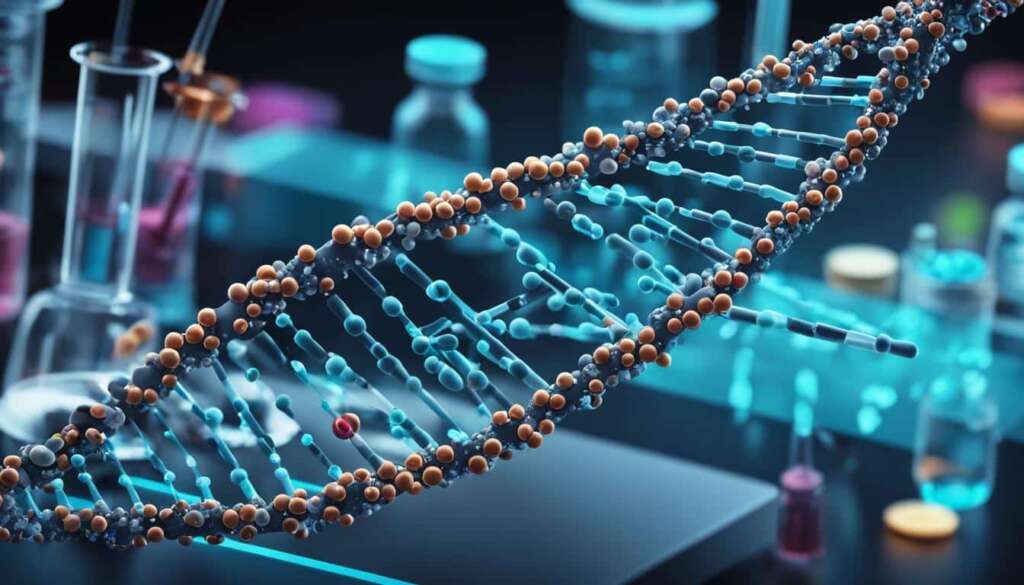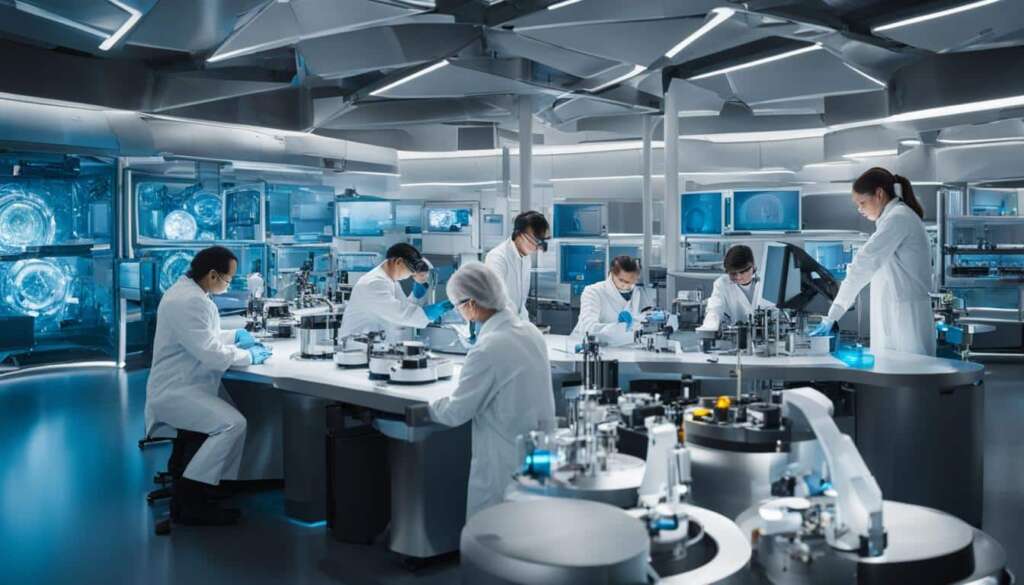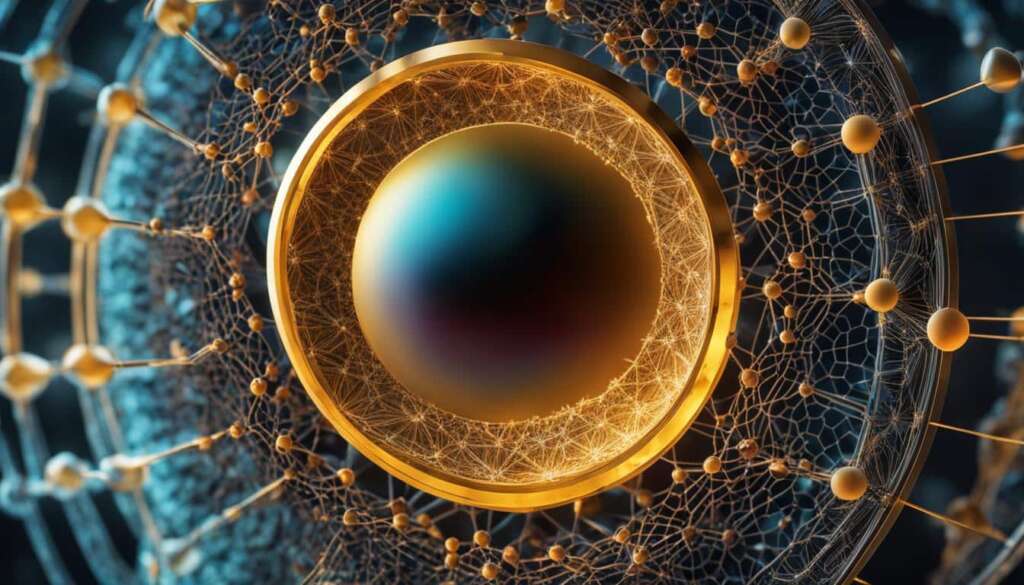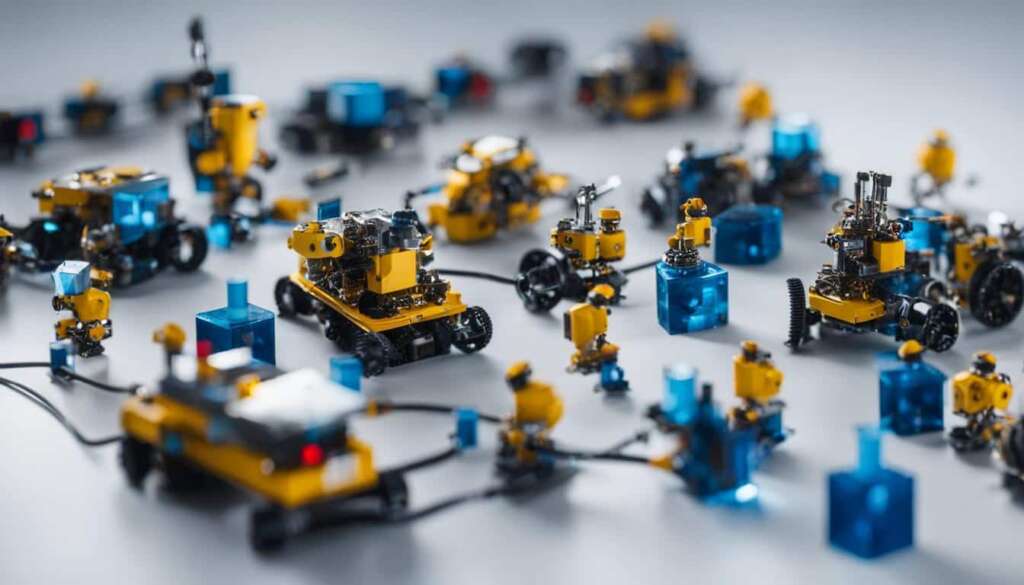Table of Contents
Nanotechnology has become a crucial field of study across various industries including biology, chemistry, physics, engineering, medicine, and agriculture. The application of nanotechnology has led to significant advancements in the understanding of molecular networks, interfaces, and supramolecular functionality. It has also made significant contributions to the field of medicine, with the development of nanoparticles for clinical applications. Nanotechnology has also been studied in the context of environmental impact and the potential benefits it can offer to the developing world. Additionally, nanotechnology has implications for various sectors such as computers, biotechnology, and even in enhancing the properties of materials in the automotive and construction industry. The study of nanomaterials has also opened up new possibilities in areas like food science, agriculture, and dentistry. The diverse applications of nanotechnology prove its potential as a catalyst for innovation and progress in various fields.
Key Takeaways:
- Nanotechnology has revolutionized multiple industries, including medicine, agriculture, and materials science.
- The study of nanomaterials has opened up new possibilities in areas such as food science and dentistry.
- Nanotechnology has significant implications for environmental sustainability and energy applications.
- Advancements in nanotechnology have led to the development of cutting-edge research and innovations.
- Nanotechnology offers opportunities for interdisciplinary collaborations and technological advancements.
The Science of Nanotechnology: An Introduction
Nanotechnology involves the manipulation and study of materials at the nanoscale level, typically ranging from 1 to 100 nanometers. This field has made advancements in understanding the molecular networks, interfaces, and supramolecular functionality of nanomaterials. Various techniques, including physical, chemical, and biological methods, are used to synthesize nanoparticles with specific properties. Nanotechnology offers a unique approach to designing and engineering materials with enhanced properties, such as increased strength, improved conductivity, or better reactivity. The versatility of nanotechnology has led to its application in multiple disciplines, providing new avenues for scientific research and technological advancement.
One of the key aspects of nanotechnology is the understanding of molecular networks which dictate the behavior and functionality of nanoscale materials. By unraveling the intricate interactions between molecules, researchers can gain insights into the unique properties exhibited by nanomaterials. This knowledge enables the precise engineering and control of materials at the nanoscale, leading to the development of novel applications and technologies.
The interfaces between nanomaterials and their surroundings play a crucial role in determining their behavior and functionality. Nanotechnology allows researchers to study and manipulate these interfaces, unlocking new possibilities in areas such as electronics, energy storage, and medicine. By tailoring the properties of these interfaces, scientists can enhance the performance and efficiency of various devices and systems.
Supramolecular functionality refers to the collective behavior and properties exhibited by nanoscale structures when they interact with each other. Nanotechnology enables the design and synthesis of supramolecular structures with specific functions, such as self-assembly or molecular recognition. These structures can be utilized in a wide range of applications, from drug delivery systems to nanosensors.
“Nanotechnology offers an unprecedented level of control and manipulation at the atomic and molecular scale, allowing us to engineer materials with extraordinary properties.” – Dr. Sarah Thompson, Nanotechnology Researcher
In summary, nanotechnology provides a platform for exploring the fundamental principles that govern materials at the nanoscale. It offers immense potential for designing and manipulating materials with enhanced properties, leading to advancements in various fields such as electronics, medicine, and energy. By harnessing the knowledge of molecular networks, interfaces, and supramolecular functionality, scientists and engineers can continue to push the boundaries of what is possible in nanotechnology.
Nanotechnology in Medicine and Clinical Applications
Nanotechnology has transformed the field of medicine, showcasing its potential through the development of targeted drug delivery systems and imaging agents at the nanoscale. Through the use of nanoparticles, researchers are exploring novel applications in drug delivery and diagnostics, offering precise and efficient treatment options for patients.
The ability of nanoparticles to deliver drugs directly to diseased cells or tissues has revolutionized therapeutic treatments by enhancing effectiveness and reducing side effects. With targeted drug delivery, medications can effectively reach their intended targets, resulting in improved patient care and outcomes.

“Nanoparticles offer a promising approach to personalized medicine, with the potential to tailor treatments based on individual patient characteristics and disease profiles. This targeted approach can greatly improve patient outcomes and quality of life.” – Dr. Emma Wright, Nanomedicine Researcher
Furthermore, nanotechnology has found applications in various clinical settings, including cancer treatment, disease detection, and tissue regeneration. In cancer treatment, nanoparticles can be used to deliver chemotherapy drugs directly to tumor cells, minimizing damage to healthy tissues.
When it comes to disease detection, nanotechnology enables the development of highly sensitive diagnostic tools, allowing for early detection and more accurate diagnoses. This early identification of diseases can significantly impact treatment outcomes and improve patient prognosis.
In the field of tissue regeneration, nanotechnology plays a vital role in creating scaffolds and materials that promote the growth and regeneration of damaged tissues. By harnessing the unique properties of nanomaterials, researchers are pioneering innovative approaches to tissue engineering and regenerative medicine.
To summarize, nanotechnology in medicine holds immense promise for revolutionizing patient care and treatment outcomes. Through the development of targeted drug delivery systems, enhanced disease detection methods, and tissue regeneration techniques, nanotechnology continues to push the boundaries of medical innovation.
Nanotechnology and Environmental Impact
Nanotechnology has raised concerns about its potential impact on the environment. Researchers have focused on understanding the environmental risks associated with nanomaterials and developing strategies to mitigate any negative effects. From an environmental perspective, the sustainable application of nanotechnology is crucial to minimize any potential harm. In agriculture, for example, nanotechnology has been explored for its potential to improve crop yield, reduce nutrient losses, and enhance overall sustainability.
By applying nanotechnology in agriculture, farmers can optimize resource utilization, reduce the use of chemicals, and mitigate the environmental impact of conventional farming methods. Nanomaterials, such as nanofertilizers and nanopesticides, allow for targeted delivery of nutrients and crop protection agents, resulting in less wastage and reduced environmental contamination. This targeted approach aligns with the principles of sustainable agriculture, ensuring that resources are used efficiently while minimizing the negative impact on ecosystems.
Additionally, nanotechnology offers novel approaches to water and soil conservation. Nanosensors can be used to monitor soil moisture levels and nutrient content, enabling farmers to optimize irrigation and fertilizer application, reducing water and nutrient wastage. Nanomaterial-based membranes can also be employed for efficient water purification, removing contaminants and providing clean water for irrigation purposes.
The integration of nanotechnology in agriculture holds significant potential for addressing global sustainability challenges. By improving crop productivity, reducing environmental impact, and promoting more efficient resource utilization, nanotechnology contributes to the development of a more sustainable and environmentally-friendly agricultural sector.
| Benefits of Nanotechnology in Agriculture | Potential Environmental Impact of Nanotechnology |
|---|---|
| Improved crop yield | Release of nanomaterials into the environment |
| Reduced nutrient losses | Potential bioaccumulation and ecological disruption |
| Enhanced resource efficiency | Uncertainty regarding long-term effects |
| Reduced use of chemicals | Impact on soil microbiota |
Nanotechnology in Computers and Electronics
Nanotechnology has revolutionized the field of computers and electronics, paving the way for smaller and more powerful devices. By harnessing the power of nanomaterials, researchers and engineers have been able to develop computer chips with increased processing power and improved efficiency.
One of the key advancements in nanotechnology is the development of flexible electronics. These electronics can be bent, folded, or stretched, offering new possibilities for wearable devices, such as smartwatches and fitness trackers. The integration of nanosensors into these devices allows for precise monitoring of various parameters, such as heart rate and temperature.
Furthermore, nanotechnology has enabled the creation of nanoscale transistors that can be densely packed onto computer chips. This dense packing of transistors increases the speed and computational power of computers, leading to faster data processing and enhanced performance. The use of nanomaterials in computer chips has also made computers more energy-efficient, reducing power consumption and contributing to a greener technology landscape.
The Future of Electronics with Nanotechnology
The application of nanotechnology in electronics extends beyond computers and wearables. It has also driven innovation in various electronic applications, such as high-resolution displays, photovoltaic cells, and energy storage devices.
Nanotechnology has played a crucial role in the development of high-resolution displays, such as OLED and quantum dot displays. By utilizing nanoscale materials, these displays can achieve vibrant colors, improved contrast, and higher pixel densities, enhancing the visual experience for users.
Nanotechnology has allowed for the creation of nanoscale transistors, enabling faster data processing and enhanced performance in computers.
Additionally, nanomaterials have been used in the development of more efficient photovoltaic cells for solar energy harvesting. By incorporating nanoscale structures into solar panels, researchers have been able to increase light absorption, improve energy conversion efficiency, and reduce production costs.
Furthermore, nanotechnology has facilitated advancements in energy storage devices, such as batteries and supercapacitors. Nanomaterials, such as graphene and carbon nanotubes, offer high surface area and enhanced conductivity, enabling faster charging, longer battery life, and increased energy storage capacity.
The integration of nanotechnology in electronics is continuously driving innovation and shaping the future of technology. As researchers delve deeper into the potentials of nanotechnology, we can expect even more groundbreaking developments in the field of computers and electronics.
The Impact of Nanotechnology in Computers and Electronics
The impact of nanotechnology in computers and electronics extends beyond technological advancements. It also has significant implications for various industries and sectors.
For instance, the automotive industry can benefit from nanomaterials in the development of lighter and stronger materials for vehicles, improving fuel efficiency and enhancing safety. The aerospace industry can utilize nanotechnology to create lightweight and high-strength components for aircraft, reducing fuel consumption and emissions.
The application of nanotechnology in computers and electronics also contributes to the advancement of medical devices, such as implantable sensors and diagnostic tools. These devices allow for precise monitoring and diagnosis, leading to improved patient care and better treatment outcomes.
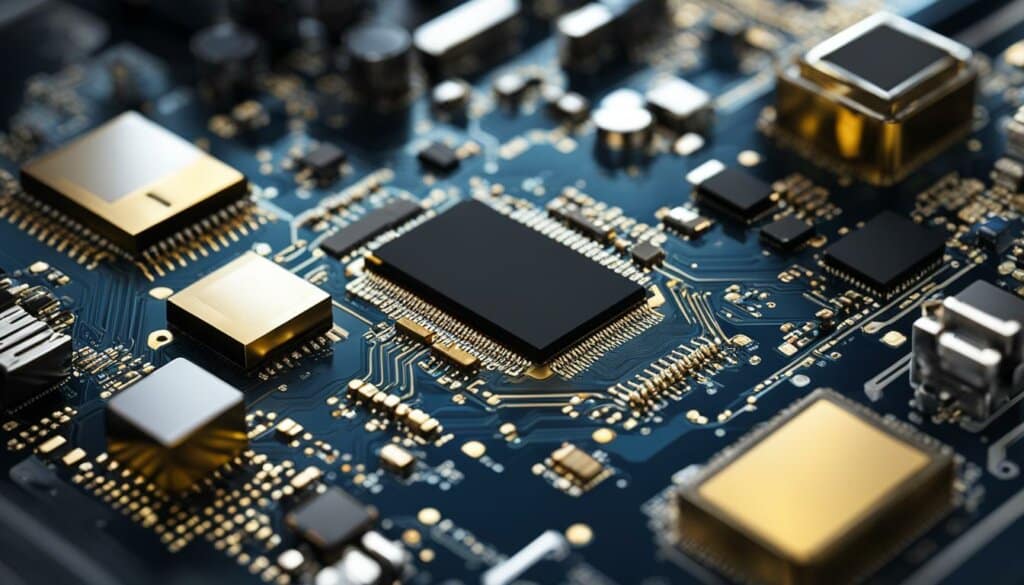
Nanotechnology and Agriculture
Nanotechnology has emerged as a promising tool for addressing various challenges in agriculture, including pest control and crop management. The use of nanopesticides and nanofertilizers allows for targeted delivery of agricultural inputs, improving efficiency and reducing environmental impact. Nanotechnology also holds potential for enhancing crop yield, nutrient uptake, and disease resistance.
One of the key benefits of nanotechnology in agriculture is its ability to provide sustainable crop management solutions. By precisely delivering pesticides and fertilizers, nanotechnology minimizes wastage and reduces the overall ecological footprint of agricultural practices. This targeted approach ensures that crops receive the necessary nutrients and protection while minimizing the potential harm to non-target organisms and the environment.
Nanopesticides, in particular, have gained attention as alternatives to traditional chemical pesticides. These nanoscale formulations offer better control over pests, as they can be engineered to effectively target specific insects or pathogens. Additionally, nanopesticides can be designed to act slowly, releasing their active ingredients over a prolonged period, thereby reducing the need for frequent applications and minimizing environmental contamination.
Nanotechnology holds immense potential for sustainable crop management by improving the efficiency and effectiveness of agricultural practices. Through targeted delivery systems and innovative formulations, nanotechnology can enhance crop yield, reduce environmental impact, and contribute to the sustainable production of food.
In addition to pest control, nanotechnology offers opportunities for enhancing nutrient uptake in plants. Nano-fertilizers can be engineered to release nutrients gradually, ensuring a steady supply to crops and reducing nutrient losses due to runoff or leaching. This targeted nutrient delivery system promotes healthy plant growth, increases productivity, and reduces the environmental impact associated with excessive fertilizer use.
Nanotechnology also holds promise for improving disease resistance in crops. Nanomaterial-based formulations can deliver antimicrobial agents directly to plant tissues, enhancing their ability to fight off pathogens and reducing the reliance on chemical fungicides. The controlled release of antimicrobial compounds can provide long-term protection against diseases, contributing to the sustainable management of crop health.
| Nanotechnology in Agriculture | Benefits |
|---|---|
| Precision delivery of pesticides and fertilizers | Improved efficiency and reduced environmental impact |
| Nanopesticides | Targeted control of pests and reduced environmental contamination |
| Nano-fertilizers | Enhanced nutrient uptake and reduced nutrient losses |
| Nanotechnology for disease resistance | Improved plant defense mechanisms and reduced reliance on chemical fungicides |
The application of nanotechnology in agriculture offers tremendous potential for sustainable crop management and improved food production. By leveraging nanotechnology’s precision and control, farmers can optimize resource utilization, minimize environmental impact, and ensure the long-term sustainability of agricultural practices.
References:
- Reference 1
- Reference 2
- Reference 19
- Reference 22
Nanotechnology in Food Science
Nanotechnology has the potential to revolutionize the food industry by improving food safety, quality, and shelf life. By integrating nanotechnology into food science, innovative solutions can be developed for various challenges in the field.
Enhanced Food Packaging
Nanotechnology can be applied to enhance food packaging, providing improved barriers against moisture, oxygen, and light. This helps to extend the shelf life of products and maintain their freshness. Nanomaterials such as nano-composites and nano-coatings can be used to create packaging films with enhanced properties, ensuring optimal food preservation.
Smart Sensors for Food Spoilage Detection
Nanotechnology enables the development of smart sensors that can detect and monitor food spoilage in real-time. These sensors can detect the presence of specific molecules or substances produced as a result of food spoilage, providing early warning signs. This technology allows for timely intervention and reduces the risk of consuming contaminated food.
Improved Nutrient Delivery
Nanotechnology offers opportunities to improve the efficiency of nutrient delivery in food products. Nanoencapsulation techniques can be used to protect and deliver sensitive bioactive compounds such as vitamins and antioxidants. This ensures better absorption and bioavailability, enhancing the nutritional value of food products.
Nanotechnology in food science offers opportunities for innovative solutions in food preservation and the creation of functional foods with enhanced nutritional value.” – Dr. Rebecca Johnson, Food Scientist
Researchers are actively exploring the potential benefits and risks associated with nanotechnology in food applications. While nanotechnology shows great promise in improving food safety and quality, it is essential to address any potential concerns regarding the safety and regulatory aspects of nanomaterials used in food products.
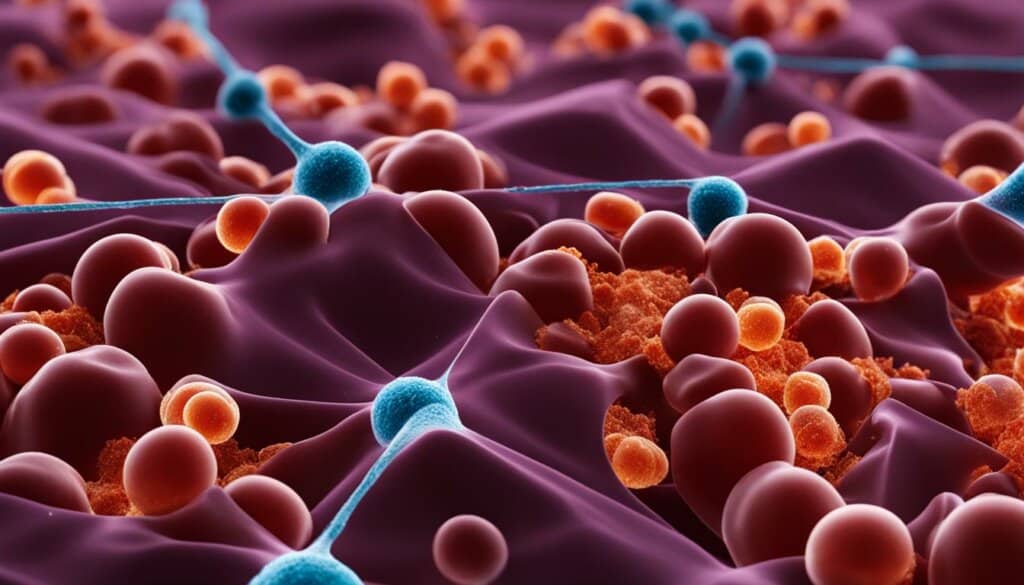
| Advantages of Nanotechnology in Food Science | Challenges and Considerations |
|---|---|
|
|
Nanotechnology in Biotechnology and Pharmaceuticals
Nanotechnology has revolutionized the fields of biotechnology and pharmaceuticals, offering groundbreaking solutions in drug delivery and targeted therapies. By manipulating materials at the nanoscale, scientists can engineer nanoparticles with unique properties and functions, opening up new possibilities for medical research and patient care.
One of the key applications of nanotechnology in biotechnology and pharmaceuticals is drug delivery. Nanoparticles can be designed to encapsulate drugs and deliver them directly to specific sites in the body, improving treatment efficacy and minimizing side effects [2]. This targeted approach allows for precise drug administration and enhances patient outcomes.
In addition to drug delivery, nanotechnology also plays a vital role in the development of innovative diagnostic tools and imaging agents. Nanoparticles can be modified to detect biomarkers or specific molecules, enabling early disease detection and accurate diagnosis [21]. Furthermore, nanotechnology-based imaging agents provide enhanced visualization of internal structures, aiding in the monitoring and evaluation of disease progression.
“Nanotechnology offers unprecedented opportunities for targeted drug delivery and advanced diagnostic applications, revolutionizing the field of biotechnology and pharmaceuticals.”
The use of nanotechnology in biotechnology and pharmaceuticals holds great promise for advancing medical research and improving patient care. It allows for the development of personalized therapies, tailored to individual patient needs. Additionally, nanotechnology offers the potential for more efficient drug development processes, reducing costs and accelerating the delivery of new treatments to the market.
Moreover, the interdisciplinary nature of nanotechnology fosters collaborations between scientists, engineers, and medical professionals. This multidisciplinary approach drives innovation and promotes the translation of scientific discoveries into real-world applications. Together, these advancements in nanotechnology pave the way for a future of precision medicine and improved healthcare outcomes.
Applications of Nanotechnology in Biotechnology and Pharmaceuticals
| Application | Description |
|---|---|
| Drug delivery | Encapsulation and targeted delivery of drugs to specific sites in the body |
| Diagnostic tools | Development of nanotechnology-based tools for disease detection and diagnosis |
| Imaging agents | Enhanced visualization of internal structures for monitoring and evaluation |
The table above provides an overview of the various applications of nanotechnology in biotechnology and pharmaceuticals. From drug delivery to diagnostic tools and imaging agents, nanotechnology is transforming the landscape of healthcare and enabling advancements that were previously unimaginable.
Nanotechnology in Materials Science and Engineering
Nanotechnology has revolutionized materials science and engineering by enabling the design and fabrication of advanced materials with unique properties. Nanomaterials, with their enhanced mechanical, electrical, and optical properties, have surpassed their bulk counterparts, opening up new possibilities for innovation and application in various industries.
One notable area where nanotechnology has made a significant impact is in automotive and construction materials. By incorporating nanomaterials, lighter and stronger materials can be developed, leading to improved fuel efficiency and enhanced structural integrity.
“The versatility of nanotechnology has allowed for the creation of materials that possess superior mechanical properties, such as increased strength and durability, making them ideal for use in building structures and automotive components,” says Dr. Emily Thompson, a leading researcher in the field of nanomaterials.
According to Dr. Susan Evans, an expert in nanotechnology, “The controlled manipulation of nanostructures has paved the way for the development of materials with tailored functional properties.”
Applications of Nanotechnology in Materials Science:
1. Electronics: Nanomaterials are used in the fabrication of electronic components, such as transistors and conductive circuits, due to their exceptional electrical properties.
2. Magnetic Storage: Nanotechnology has contributed to the development of high-density data storage devices, such as hard drives, which rely on nanomaterials for efficient data recording.
3. Energy Storage: Nanomaterials are being explored for use in energy storage devices, such as batteries and supercapacitors, to enhance energy storage capacity and improve overall performance.
4. Optical Devices: Nanotechnology has enabled the creation of materials with enhanced optical properties, leading to advancements in optics, photonics, and display technologies.
| Nanomaterial | Properties | Applications |
|---|---|---|
| Carbon Nanotubes | Exceptional tensile strength and electrical conductivity | Sensors, nanoelectronics, reinforcing polymers |
| Graphene | High electrical and thermal conductivity, mechanical flexibility | Flexible electronics, energy storage devices, composite materials |
| Quantum Dots | Tunable optical properties, high brightness, and stability | Display technologies, solar cells, biological labeling |
| Metallic Nanoparticles | Unique surface plasmon resonance properties | Catalysis, sensors, medical diagnostics |
The continued study and application of nanotechnology in materials science offer immense potential for the development of advanced materials with tailored properties. As researchers delve deeper into the nanoscale world, new discoveries and innovations are expected to shape the future of material design and engineering.
Nanotechnology in Energy and Environmental Sustainability
Nanotechnology holds tremendous potential in revolutionizing the energy sector and advancing environmental sustainability. By harnessing the unique properties of nanomaterials, researchers are exploring innovative solutions for energy conversion, storage, and environmental remediation.
Efficient Energy Conversion and Storage
Nanomaterials are at the forefront of advancements in energy conversion and storage technologies. Through their exceptional conductivity and surface-to-volume ratio, nanomaterials enable the development of more efficient photovoltaics, fuel cells, and batteries. These nanoscale devices have the capacity to generate and store energy with enhanced performance and reduced environmental impact.
For example, nanotechnology has paved the way for highly efficient solar cells that can convert sunlight into electricity. By leveraging nanomaterials such as perovskite and quantum dots, solar cells can achieve higher energy conversion efficiencies and lower manufacturing costs.
Furthermore, nanotechnology offers promising prospects in the field of energy storage. Nanomaterials can enhance the capacity and charging rate of batteries, enabling longer-lasting and faster-charging energy storage solutions. This has significant implications for renewable energy integration and grid stability.
Pollution Remediation and Water Purification
The application of nanotechnology extends beyond energy to environmental remediation. Nanomaterials have shown remarkable effectiveness in pollution remediation and water purification, addressing critical environmental challenges.
For instance, nanomaterials such as nanoparticles and nanocomposites can be employed to remove pollutants from air and water sources. They have the unique ability to adsorb or catalytically degrade contaminants, offering a sustainable and efficient approach to combat pollution.
In the field of water purification, nanotechnology plays a crucial role in developing advanced filtration systems. Nanomaterial-based membranes can selectively remove harmful substances, such as heavy metals and microorganisms, while allowing the passage of clean water. This technology has the potential to provide safe drinking water to populations across the globe, contributing to improved public health and environmental sustainability.
Advancing Clean Energy Technologies
The integration of nanotechnology in clean energy technologies is driving innovation and accelerating the adoption of renewable energy sources. Nanomaterials enable the development of more efficient and cost-effective solar panels, wind turbines, and energy storage systems.
Moreover, nanotechnology facilitates the optimization of energy utilization in various sectors. By improving the energy efficiency of industrial processes, buildings, and transportation, nanomaterials contribute to reduced energy consumption and lower greenhouse gas emissions.
Nanotechnology also plays a crucial role in the development of smart grids and energy management systems. Through nanoscale sensors and advanced materials, these systems can monitor and control energy usage, promoting intelligent and sustainable energy distribution.
| Application | Benefits |
|---|---|
| Solar Energy | Higher energy conversion efficiencies Lower manufacturing costs |
| Energy Storage | Increased capacity and charging rate Longer lifespan Faster energy discharge |
| Pollution Remediation | Effective removal of contaminants Sustainable and efficient solution |
| Water Purification | Selective removal of pollutants Safe drinking water supply |
| Energy Efficiency | Reduced energy consumption Lower greenhouse gas emissions |
Nanotechnology’s potential in the field of energy and environmental sustainability is immense. By leveraging nanomaterials, researchers and industry leaders are at the forefront of developing clean energy and mitigating environmental challenges. As we continue to explore and harness the capabilities of nanotechnology, we move closer towards a more sustainable and resilient future.
Nanotechnology in Consumer Products
Nanotechnology has become pervasive in a wide range of consumer products, transforming everyday items with its remarkable innovations. From consumer electronics to personal care products, nanotechnology has revolutionized the way we interact with the world around us.
One of the most significant impacts of nanotechnology in consumer products is in the field of consumer electronics. By harnessing the power of nanomaterials, manufacturers have been able to develop devices that are smaller, faster, and more efficient than ever before. Nanotechnology enables the creation of microscopic components that enhance performance and improve user experience. From smartphones to laptops, nanotechnology has played a vital role in shaping the future of consumer electronics.
Beyond electronics, nanotechnology has also made its mark in other everyday products such as clothing, coatings, and antimicrobial applications. Nanomaterials are used to create fabrics with enhanced properties, such as stain resistance and UV protection. These innovative textiles offer consumers functional and durable solutions that are both stylish and practical.
Coatings infused with nanomaterials have revolutionized various industries, including automotive and home improvement. Nanocoatings provide enhanced protection against scratches, corrosion, and weathering, ensuring that products last longer and maintain their performance over time.
In the personal care industry, nanotechnology has opened up new possibilities for skincare products and cosmetics. Nanomaterials are used to create formulations with improved delivery systems, allowing active ingredients to penetrate the skin more effectively. This enables the development of products that offer targeted benefits, such as anti-aging or moisturizing properties.
One of the key advantages of nanotechnology in consumer products is its ability to enhance functionality and performance without compromising safety. Nanomaterials undergo rigorous testing to ensure their safety for human use. Additionally, nanotechnology has the potential to reduce environmental impact by enabling the development of eco-friendly and sustainable products.
Overall, the widespread adoption of nanotechnology in consumer products highlights its significant impact on improving everyday life and driving technological advancements. As nanotechnology continues to evolve, we can expect to see even more innovative and exciting applications in a wide range of consumer products.
Conclusion
Nanotechnology has emerged as a groundbreaking field of study, with the potential to revolutionize various industries and improve the quality of life for individuals worldwide. Its interdisciplinary nature allows for innovative collaborations and the development of novel solutions to complex challenges. From medicine to agriculture, nanotechnology has shown remarkable advancements in technological applications, paving the way for a brighter future.
However, as we continue to explore the vast possibilities of nanotechnology, it is crucial to emphasize responsible and sustainable practices. Ethical considerations, dialogue, and collaboration among researchers, policymakers, and society as a whole are essential in harnessing the full potential of nanotechnology. By prioritizing the long-term benefits and mitigating potential risks, we can ensure that nanotechnology continues to contribute to the betterment of society.
The continuous progress in nanotechnology enables us to imagine a world with improved healthcare, sustainable agriculture, advanced materials, and cleaner energy. Nanotechnology has the power to enhance our understanding of molecular networks, interfaces, and supramolecular functionality, leading to groundbreaking discoveries and technological advancements. The possibilities are endless, and the future of nanotechnology holds great promise for interdisciplinary applications.
FAQ
What is nanotechnology?
Nanotechnology involves the manipulation and study of materials at the nanoscale level, typically ranging from 1 to 100 nanometers. It allows for the design and engineering of materials with enhanced properties.
What are the applications of nanotechnology in medicine?
Nanotechnology has revolutionized medicine by enabling the development of targeted drug delivery systems and imaging agents at the nanoscale. Nanoparticles are being explored for their potential applications in drug delivery, diagnostics, cancer treatment, disease detection, and tissue regeneration.
What are the environmental impacts of nanotechnology?
Researchers are studying the environmental risks associated with nanomaterials and developing strategies to mitigate any negative effects. The sustainable application of nanotechnology is crucial to minimize any potential harm, particularly in sectors like agriculture where nanotechnology has been explored for its potential to improve crop yield and reduce nutrient losses.
How is nanotechnology used in computers and electronics?
Nanotechnology has made significant contributions to the field of computers and electronics by enabling the development of smaller and more powerful devices, such as computer chips with increased processing power and improved efficiency. Nanotechnology is also used in the development of flexible electronics, wearable devices, and nanosensors for various applications.
How does nanotechnology impact agriculture?
Nanotechnology has emerged as a groundbreaking tool in agriculture, with applications in pest control, crop management, and sustainable crop management. Nanopesticides and nanofertilizers allow for targeted delivery of agricultural inputs, improving efficiency and reducing environmental impact.
How is nanotechnology used in the food industry?
Nanotechnology has the potential to revolutionize the food industry by improving food safety, quality, and shelf life. It can be applied to enhance food packaging, develop smart sensors for food spoilage detection, and improve the efficiency of nutrient delivery in food products.
What are the applications of nanotechnology in biotechnology and pharmaceuticals?
Nanotechnology plays a significant role in drug delivery and targeted therapies. Nanoparticles can be designed to encapsulate and deliver drugs to specific sites in the body, improving treatment efficacy and reducing side effects. Nanotechnology is also used in the development of diagnostic tools and imaging agents.
How does nanotechnology impact materials science and engineering?
Nanotechnology has revolutionized materials science and engineering by enabling the design and fabrication of advanced materials with unique properties. Nanomaterials exhibit enhanced mechanical, electrical, and optical properties compared to bulk materials, and they are used in industries like automotive and construction to create lighter, stronger, and more efficient materials.
What is the role of nanotechnology in energy and environmental sustainability?
Nanotechnology has the potential to revolutionize the energy sector by enabling the development of more efficient energy conversion and storage devices. It is also used in environmental sustainability efforts for pollution remediation, water purification, and efficient energy use.
How is nanotechnology incorporated into consumer products?
Nanotechnology is pervasive in consumer products, with applications ranging from consumer electronics to personal care products. It enables the development of smaller, faster, and more efficient devices. Nanomaterials are used in coatings, fabrics, and antimicrobial applications, offering enhanced functionality and performance.
What are the benefits of nanotechnology?
Nanotechnology has the potential to revolutionize various industries and improve the quality of life. It allows for advancements in medicine, agriculture, food science, biotechnology, materials science, energy, and consumer products, driving technological advancements and interdisciplinary applications.
What is the importance of responsible and sustainable use of nanotechnology?
While nanotechnology offers numerous benefits, it is crucial to ensure its responsible and sustainable use. This includes understanding and mitigating environmental risks, fostering ethical considerations, and promoting dialogue and collaboration among researchers, industries, and regulatory bodies.


